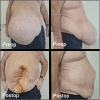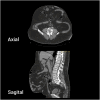Case Report: Intraoperative Fascial Traction for Increasing Intra-Abdominal Volume in Loss-of-Domain Incisional Hernias: A Report of Two Cases
- PMID: 40162323
- PMCID: PMC11949753
- DOI: 10.3389/jaws.2025.14283
Case Report: Intraoperative Fascial Traction for Increasing Intra-Abdominal Volume in Loss-of-Domain Incisional Hernias: A Report of Two Cases
Abstract
Introduction: The primary goal in incisional hernia repair is achieving primary fascial closure and reinforcing the area with a synthetic mesh. However, when Loss of Domain (LoD) is present, serious complications such as intra-abdominal hypertension (IAH) and abdominal compartment syndrome (ACS) may arise. Various strategies have been employed to overcome these challenges and increase the reduced intra-abdominal volume, including preoperative botulinum toxin (BTA) injection, progressive pneumoperitoneum (PPP), various component separation techniques, and their combinations. Intraoperative fascial traction (IFT) has recently been added to this armamentarium. The two cases presented here aim to demonstrate the potential benefits of this innovative technique and offer a different perspective to surgeons dealing with such challenging cases.
Presentation of cases: The two patients presented here had previously undergone open umbilical hernia repair with mesh-one 17 years ago and the other 5 years ago-both of whom experienced recurrence and developed LoD over time. In both cases, IFT was successfully performed, resulting in an uneventful recovery.
Discussion: The repair of incisional hernias accompanied by LoD presents significant challenges. In managing these cases, it is essential not only to optimise the patient preoperatively but also to employ interventions aimed at increasing intra-abdominal volume. In recent years, the intraoperative fascial traction (IFT) technique has emerged as a valuable tool in complex incisional hernia repairs. This technique not only facilitates primary fascial closure but also significantly increases intra-abdominal volume, potentially reducing the risks associated with intra-abdominal hypertension and compartment syndrome.
Conclusion: IFT offers promising advantages in the repair of incisional hernias with LoD, as it addresses the dual challenge of achieving primary fascial closure and restoring intra-abdominal volume. The two cases presented highlight the potential of this innovative technique in achieving successful outcomes. However, further research and larger studies are needed to fully establish its efficacy and long-term benefits in this challenging patient population.
Keywords: abdominal compartment syndrome; complex hernia; incisional hernia; intraoperative fascial traction; loss of domain.
Copyright © 2025 Gök.
Conflict of interest statement
The author declares that the research was conducted in the absence of any commercial or financial relationships that could be construed as a potential conflict of interest.
Figures
Similar articles
-
Preoperative botolinum toxin A (BTA) and intraoperative fascial traction (IFT) in the management of complex abdominal wall hernias.Hernia. 2024 Dec;28(6):2273-2283. doi: 10.1007/s10029-024-03156-z. Epub 2024 Sep 13. Hernia. 2024. PMID: 39269518 Free PMC article.
-
The Impact of Botulinum Toxin A Application on Reducing the Necessity for "Component Separation Techniques" in Giant Incisional Hernias: A Dual-Center, Polish-Ukrainian, Retrospective Cohort Study.Pol Przegl Chir. 2024 Apr 24;96(6):12-19. doi: 10.5604/01.3001.0054.4919. Pol Przegl Chir. 2024. PMID: 39635752
-
Preoperative progressive pneumoperitoneum complementing chemical component relaxation in complex ventral hernia repair.Surg Endosc. 2017 Apr;31(4):1914-1922. doi: 10.1007/s00464-016-5194-1. Epub 2016 Aug 29. Surg Endosc. 2017. PMID: 27572061
-
[Loss of domain and reduction in median suture tension].Chirurgie (Heidelb). 2024 Jan;95(1):34-41. doi: 10.1007/s00104-023-01997-5. Epub 2023 Dec 12. Chirurgie (Heidelb). 2024. PMID: 38085298 Review. German.
-
Dynamic Fascial Closure With Vacuum-Assisted Wound Closure and Mesh-Mediated Fascial Traction (VAWCM) Treatment of the Open Abdomen-An Updated Systematic Review.Front Surg. 2020 Nov 5;7:577104. doi: 10.3389/fsurg.2020.577104. eCollection 2020. Front Surg. 2020. PMID: 33251242 Free PMC article.
References
Publication types
LinkOut - more resources
Full Text Sources
Research Materials





